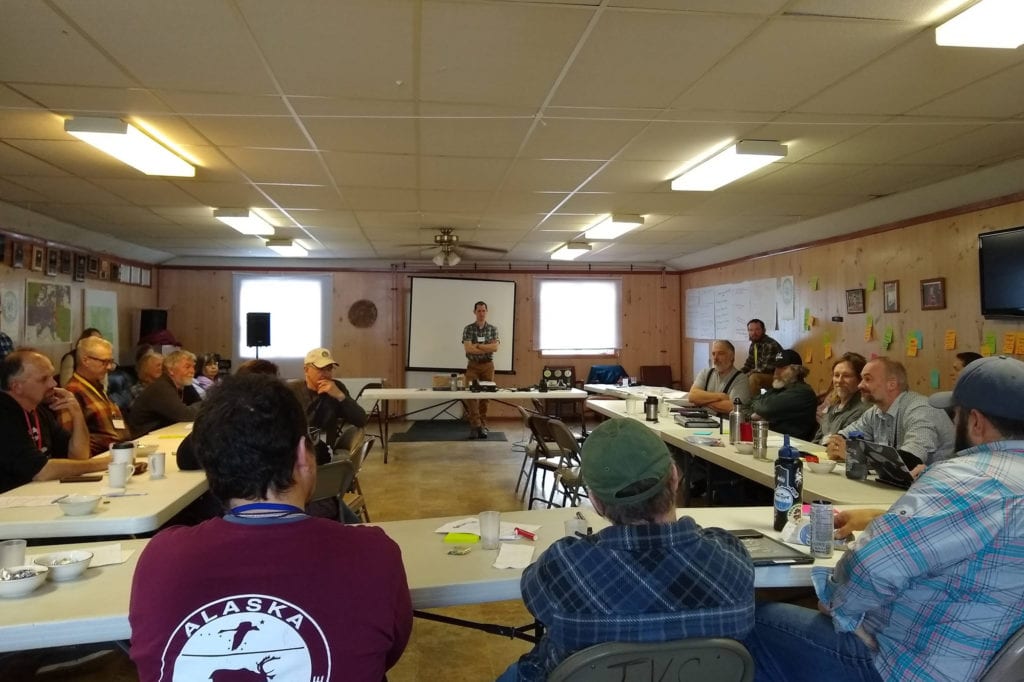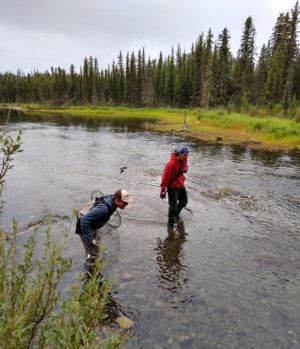
In late February, Prince William Sound Science Center research ecologists Pete Rand and Kristen Gorman traveled, for the second time in the last year, to the upper Copper River Watershed. This time, not to collect data for their Copper River Sockeye Salmon migration energetics research, but to join anthropologists, geologists, climate scientists, other biologists, and indigenous leaders at the Copper River Basin Symposium in Copper Center.
The symposium was unique in the diversity of topics covered, all tied together with a common thread of place — the Copper River Basin. Following this event, a separate gathering took place involving fishery stakeholders, providing a unique opportunity for salmon harvesters to share their knowledge and talk about the fishery. The Copper River Watershed Project was instrumental in planning these two events.
Within a short time of receiving funding from the North Pacific Research Board for their salmon study, Rand and Gorman realized that the Copper River Basin was a different animal than they were used to on the Copper River Delta or in Prince William Sound. The permitting process alone alluded to the complexity of the landscape. Permits from the Alaska Department of Fish and Game, Ahtna, Inc., and the National Park Service were all required before data collection could begin. The meetings brought people from these and other agencies and organizations together, providing a valuable opportunity for researchers to network with individuals in these organizations.
Typical research conference presentations and posters were intermixed with panel discussions and opportunities to network for future collaboration. A panel discussion on the second day of the symposium used Rand and Gorman’s research as a case study for working with indigenous communities in the region. Pete and Kristen reached out to Karen Linnell and Bruce Cain with the Ahtna Intertribal Resource Commission early in the season for help with their project. Cain connected Rand and Gorman with people who were very knowledgeable about salmon in the region, and Cain led the symposium panel at the meeting. Ahtna community members, particularly from the village of Mentasta, were the key to success during the first year of the field project.
“We were able to hit the ground running with their generous help, particularly helping us get access to some of the more remote field sites,” Rand recounts. The panel inspired considerable discussion on both the value and challenges of working with regional indigenous communities.

“It should go without saying, but rule number one is respect the people and their land, and take every opportunity to learn from the elders,” Rand said.
As Nick Jackson, an Ahtna elder that welcomed the attendees at the meeting, pointed out, “You’ve got to walk the land to know the land.”
During the panel, Linnell and Cain emphasized the importance of establishing relationships early, especially during the design and proposal phase.
“Be as transparent and open as possible with what you plan to do,” Pete recalls from the meeting. There are elders in the Ahtna community that have a long history of the fish and fisheries and they know a lot about the timing and location of where the fish can be found. By developing these relationships, you can tap into a wealth of information.
The third day of the Copper River Basin Symposium presented a unique opportunity to focus on synthesizing knowledge about salmon. Rand and Gorman participated in this gathering, dedicated to identifying key gaps in salmon habitat research in the Copper River basin and developing research strategies for filling these gaps. Finally, through an additional outreach award by NPRB, Rand and Gorman helped plan and facilitate the Copper River Salmon Harvesters Roundtable — a gathering of the myriad of salmon user groups in the region, including commercial, sport, subsistence, and indigenous harvesters — to discuss common concerns for the Copper River fisheries.
The question that emerged repeatedly during the last two days of meetings was, “What is escapement?” All attendees agreed the monitoring work by ADF&G on estimating the number of sockeye salmon passing Miles Lake each year using sonar and Native Village of Eyak’s work on estimating escapement of Chinook salmon using tagging methods are both extremely important, but attendees at the meetings repeatedly brought up concerns about the condition and fates of the fish farther upstream, particularly for sockeye salmon.
“If you look at the sockeye salmon monitoring data closely, you see a growing discrepancy between the lower river sonar counts at Miles Lake and the number of fish reaching the spawning grounds based on aerial surveys, particularly in recent years,” Rand said. Many came to these meetings with concern about the condition of the fish they harvested last year.
“It left an indelible impression on me; people are seeing changes in the salmon returning to their communities,” Gorman said. Many have observed a long-term decline in size, but a growing number of people are noting the presence of parasites, wounds, and overall poor physical condition of the fish they handle.
Rand and Gorman’s research is directly related to this concern. Their study is designed to understand the migration and ultimate fate of fish as they progress upriver to the spawning grounds and determine if there are traits associated with success. For example, preliminary results from the 2019 field season indicated rather poor migratory success and data show a positive correlation between the size of fish and their ability to reach points upstream. That is, the fish that were able to migrate to the upper watershed were several centimeters longer than the tagged fish that did not successfully migrate. The result is preliminary, and it is important to note that the data were collected during an extremely atypical year.
Unprecedented glacial melt led to the highest flows since the USGS started monitoring the Copper River 20 years ago. Non-glacial fed tributaries were experiencing an opposite, but equally concerning reality — high water temperatures. Rand and Gorman will be conducting a second, and longer field season in 2020 and are working to secure grants to extend their project into 2021 and beyond.
As Rand and Gorman continue to learn about the factors that contribute to the migratory success of Copper River sockeye salmon they hope the results will start a discussion on how management interacts with fisheries under increasingly variable environmental conditions both in the ocean and river. Events like the Copper River Basin Symposium and the Harvesters Roundtable provide a platform for these kinds of discussions. At these meetings Rand and Gorman were able to share results from their project as well as learn more about the Copper River system from locals and especially those with traditional knowledge.
“There are people in these communities that have a lifetime of observations on the Copper River,” Gorman said. “This knowledge is incredibly valuable as we develop new science projects.”





